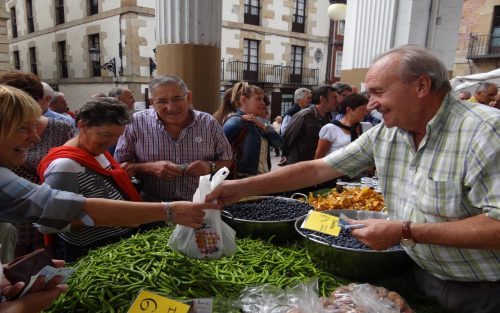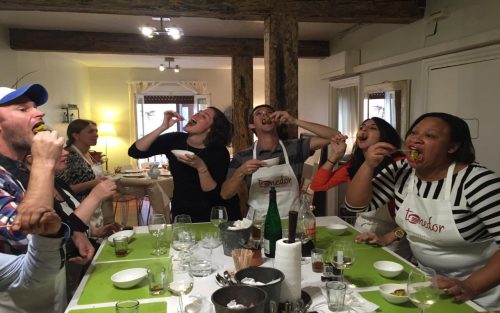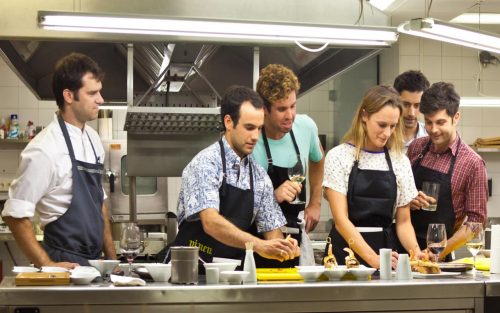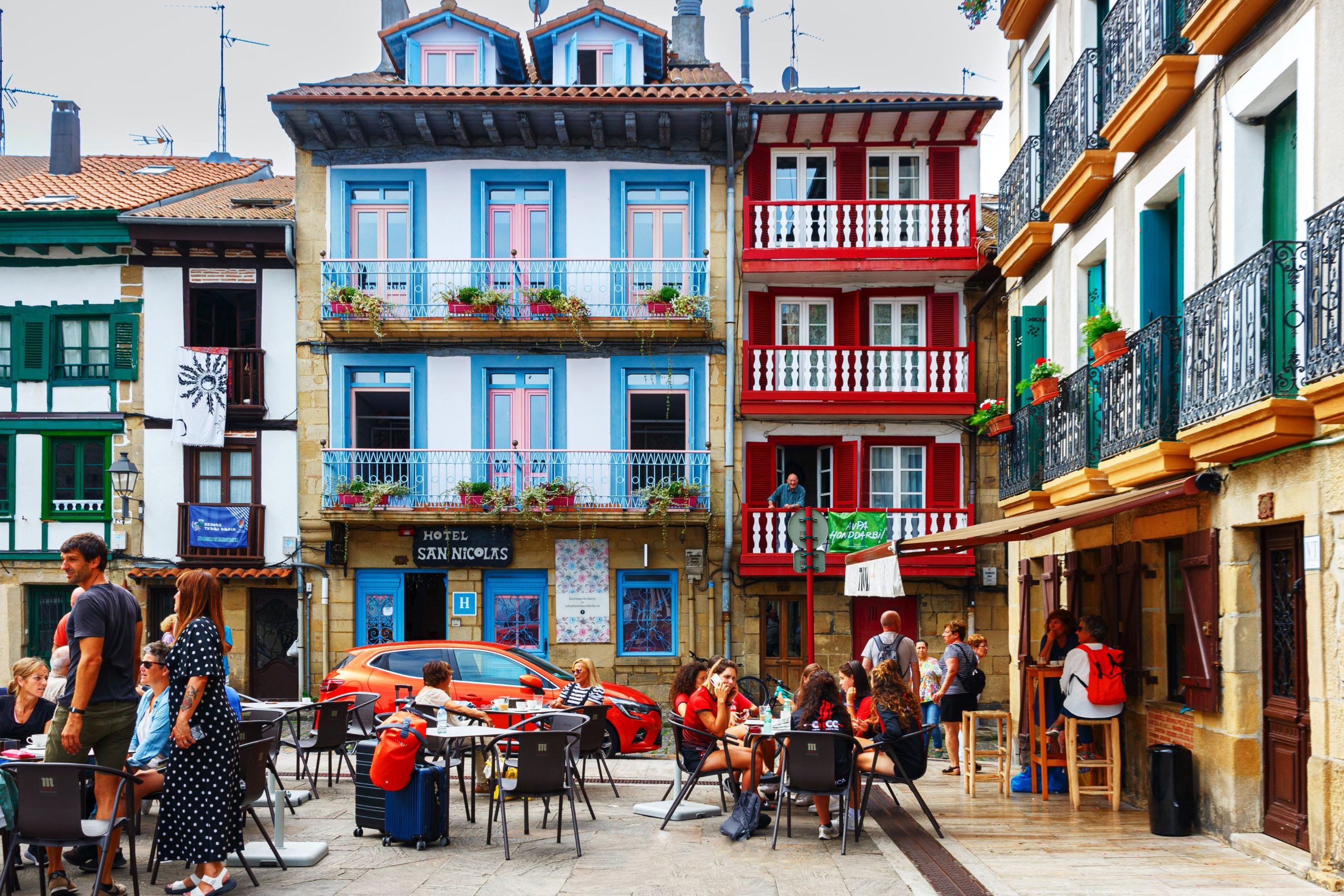Gastronomy is a vital part of everyday life in the Basque Country where you’ll discover the finest wines and gourmet food in Spain
 As tourism to Spain goes, the Basque Country in the north has few iconic landmarks and may be somewhat off the beaten path. But for those of us who seek the less-traveled one, that just adds to their allure. Perhaps the region is best known for its culinary prowess, and it has certainly capitalized on the growing interest in food and wine travel.
As tourism to Spain goes, the Basque Country in the north has few iconic landmarks and may be somewhat off the beaten path. But for those of us who seek the less-traveled one, that just adds to their allure. Perhaps the region is best known for its culinary prowess, and it has certainly capitalized on the growing interest in food and wine travel.
Celebrated for its inventive chefs and blessed with the highest concentration of Michelin-starred restaurants worldwide, the Basque Country has earned a reputation as the place for epicurean food in Spain.
In England’s most recent World’s 50 Best Restaurants awards, four on the list were in Spain’s Basque Country. Group tours may not be able to budget $200 per person for haute cuisine at the top-rated temples of gastronomy. However, even the simplest fare served up by anonymous chefs and neighborhood bars is worthy of raves.
Who Are the Basque People?
Reputedly the oldest ethnic group in Europe, the Basques have farmed the green hills and valleys of their homeland for centuries. In fact, their deep-sea fishing industry goes back to the 1500s. Specifically, fearless fishermen traveled as far as Newfoundland in search of cod. Today, the seafood from cold Atlantic waters and raw ingredients have given the Basque Country a rich food culture. Indeed, gastronomy is a hallmark of the Basque identity.
Unique Basque Country language
With a way of life all its own and a fierce independent streak, the Basque region of northern Spain is practically a country within a country. What really sets Basque apart is their language, Euskara. Speaking Euskara makes one a Basque. Unrelated to any other tongue, it appears bizarre and unpronounceable to those more familiar with the Romance or Germanic languages. You’ll see Euskara words on menus and road signs (often with the Spanish equivalents) and notice they are full of k’s, tx’s and z’s.
Basque Country cuisine
 A highlight of touring the Basque Country is indulging in one of the region’s signature treats—pintxos (pronounced “PEEN-chos”). The Basque equivalent of tapas, these exquisite little bites served at bars and cafes can range from unadorned slivers of dried Iberian ham on bread to miniature works of art reflecting the heights of nano-gastronomy. Locals make an afternoon or evening of hopping from bar to bar, selecting one or two pintxos at each and washing them down with a small glass of beer or wine. Mind you, this is all done standing or sitting at the bar rather than seated at a table. It’s more a way of socializing than having a meal.
A highlight of touring the Basque Country is indulging in one of the region’s signature treats—pintxos (pronounced “PEEN-chos”). The Basque equivalent of tapas, these exquisite little bites served at bars and cafes can range from unadorned slivers of dried Iberian ham on bread to miniature works of art reflecting the heights of nano-gastronomy. Locals make an afternoon or evening of hopping from bar to bar, selecting one or two pintxos at each and washing them down with a small glass of beer or wine. Mind you, this is all done standing or sitting at the bar rather than seated at a table. It’s more a way of socializing than having a meal.
Bar counters piled high with platters of pintxos (usually skewered on sticks or tooth-picks) are really something to behold; the sheer variety is mind-boggling. Most popular is a slice of Spanish omelette (tortilla de patata), a mixture of eggs and potato fried in oil. Everyone has a soft spot if their heart for their mother’s Spanish omelette. Also commonly found is the Gilda, an olive-anchovy-green chili pepper medley eaten in one bite. Other snack-sized morsels might include mayonnaise-based salads and grilled wild mushrooms. Another favorite is the huevo frito, a heavenly, deep-fried pillow of dough filled with hot, runny egg, a slice of potato and a bit of bacon.
Basque Country seafood
Seafood dominates Basque menus, and no one (except the Japanese) eats more fish per capita than the Basques. Cod (or bacalao) is the fish of choice, and hake comes next. Grouper, turbot, tuna, monkfish, jack mackerel, anchovies, baby eels, spider crab, lobster, octopus and baby squid are found everywhere as well. In fact, Basque Country accounts for the world’s largest production of squid ink. The classic dish bacalao pil pil is dried salted cod in a mayonnaise-like sauce of olive oil, chili and garlic. At any pintxo bar you’re likely to encounter salted cod, cod croquettes or crispy fried cod skin. A familiar restaurant dish is marmitako, a hearty fishermen’s stew of tuna, potatoes, and red peppers. Furthermore, fish is often accompanied by chilled txakoli, a slightly acidic white sparkling wine.
Tour Bilbao and San Sebastian in Basque Country

Bilbao in Basque Country. Photo courtesy of Lukas Stutz
In foodie havens like the coastal cities of Bilbao and San Sebastian, book your group on a walking tour of their respective Old Quarters. Make sure to stop for pintxos along the way. The walk in Bilbao may include passing through the stalls of Ribera Market, the largest indoor food market in Europe.
Tour the Guggenheim Museum

Guggenheim Museum photo courtesy of designerpoint
Aside from exploring the Old Quarter, the chief tourist activity in Bilbao is visiting the Guggenheim Museum. This incredible repository of modern art is more famous for its architecture than for the works inside. Designed by controversial architect Frank Gehry, the curvaceous jumble of gleaming titanium strips put Bilbao on the world map after its completion in 1997.
Partake in foodie tours
 In San Sebastian, Tenedor Tours (tenedortours.com) can arrange culinary activities for groups from eight to 300 guests. Besides pintxo walkabouts, the company’s New York-born owner, Gabriella Ranelli de Aguirre, can set up hands-on experiences. Try cooking classes, food market tours, farm visits, and wine, cider and craft beer tastings. Groups can also pick up some cooking secrets and enjoy lunch at a txoko, a traditionally male gastronomy club where men come together to cook and bond.
In San Sebastian, Tenedor Tours (tenedortours.com) can arrange culinary activities for groups from eight to 300 guests. Besides pintxo walkabouts, the company’s New York-born owner, Gabriella Ranelli de Aguirre, can set up hands-on experiences. Try cooking classes, food market tours, farm visits, and wine, cider and craft beer tastings. Groups can also pick up some cooking secrets and enjoy lunch at a txoko, a traditionally male gastronomy club where men come together to cook and bond.
Memberships in these culinary fraternities are passed from father to son, and many participants have been friends since childhood. More clubs, though, have been opening doors to women, and a couple even have a female president.
San Sebastian’s Michelin stars
One of Europe’s most prestigious international film festivals and a collection of Michelin-starred restaurants enhance San Sebastian’s pedigree. Lending the city an aura of sophistication, people come from everywhere to taste great food in Spain. Along with Paris, San Sebastian is the only European city with three restaurants—Arzak, Akelarre and Martin Bersasategui—boasting three Michelin stars, the French gourmet critics’ highest rating. Take a walk down the fashionable beachside promenade along Concha Bay and visions of Monte Carlo, Cannes and Nice will come to mind.
Wine Regions of the Basque Country
A Basque Country tour is not complete without a foray into the famed Rioja Alavesa wine region, an hour-and-a-half drive south of Bilbao and San Sebastian. Tucked into a relatively compact area between the southern slopes of the Sierra de Cantabria and Ebro River are endless vistas of vineyards on terraced hillsides. The vines, mostly of the red tempranillo variety, thrive in a microclimate ideal for growing grapes. This is because the vines are protected by the mountain range from coastal winds and moisture. Rioja Alavesa also hosts a thriving olive industry; olive oil sampling and olive mill visits can be arranged.
Wine in Laguardia is medieval
Many Basque Country wine tours visit Laguardia, a walled medieval town threaded with pedestrian lanes. Adorned with balconies, lines of drying laundry and religious shrines, the stone passageways invite random wandering. Incredibly, underneath the fortified town are more than 200 wine cellars.
Marques de Riscal offers unique vintages
Just as ancient Laguardia rises ship-like over the sea of vineyards, a much newer landmark looms prominently on the horizon just four miles away. Dominating Herederos del Marques de Riscal winery is the undulating tangle of purple, silver and gold metal ribbons of the estate’s Frank Gehry-designed showpiece hotel. The building is reminiscent of his Guggenheim Museum. The eruption of steel and titanium, according to one guide-book, “looks as if a colony from outer space had crashed in the middle of La Rioja’s oldest vineyards.” Dubbed “City of Wine,” Marques de Riscal is indeed the region’s oldest winery, dating from 1860. The luxury hotel features a one-star Michelin restaurant.
Astigarraga for Apples and Family-Style Meals
The town of Astigarraga, south of San Sebastian, is the center of apple-growing country. At a rustic 16th century cider house run by five generations of the Lizeaga family, visitors get a peek into another Basque Country tradition. Sit on benches at long tables with red-checked  tablecloths, amid wood beams and stone walls. Feast together on multi-course meals served family style.
tablecloths, amid wood beams and stone walls. Feast together on multi-course meals served family style.
The fare might include chorizo sausages cooked in cider, a cod omelette, cod smothered in green peppers and steak served rare. A typical dessert of cheese, walnuts and quince jelly would follow. When the spigot of the cider barrel is turned on at the cry of “txotx!” diners line up with their glasses to catch cider spurting out. The wet floor doesn’t dampen the festive atmosphere, which is sometimes enhanced by singing and accordion music.
Cheese in Idiazabal
Farther south in the Basque Highlands, cheese lovers head to Idiazabal to learn about the prized Idiazabal sheep’s milk cheese. On their way to the Idiazabal Cheese Interpretation Centre they’ll likely see sheep on the mountain slopes or being herded through town. Sheep farms and artisan cheese dairies are abundand. For instance, World Cheese Awards-winning J. Aranburu—run by brothers Juan, Javier and Jose Aranburu—offer tastings and tours.
Whether you stick to the coast or venture into the countryside, a ramble through the Basque Country will give you a taste of this ancient culture. The amazing wine and food in Spain will perhaps whet your appetite for second helpings on future travels to the Iberian peninsula.
For information on Spain’s Basque Country, contact Basque Tour (Basque Tourism Board) at https://www.basquecountry-tourism.com/ or the National Tourist Office of Spain, spain.info/en.
Never miss exciting travel news by subscribing to the current issue of Leisure Group Travel today.






